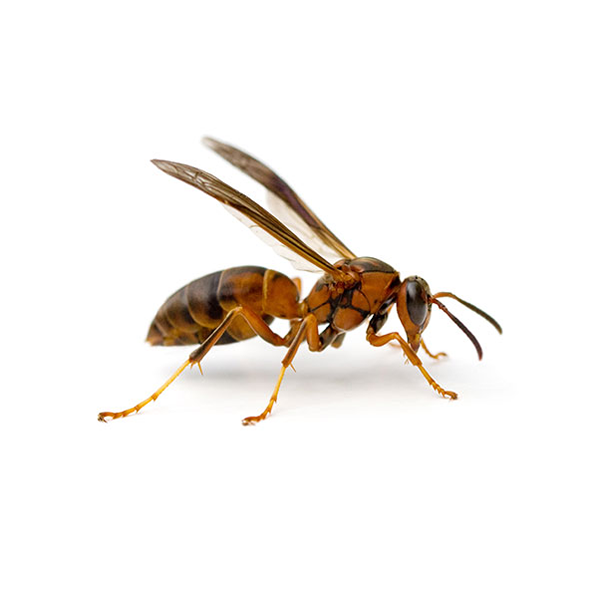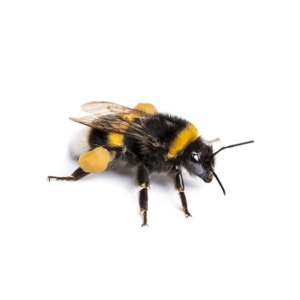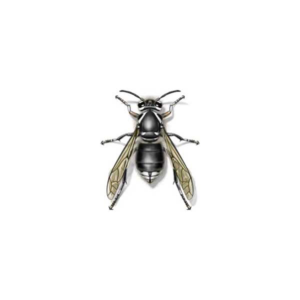Paper Wasp Identification
What Do Paper Wasps Look Like?
There are over 22 species of paper wasps in the U.S., and most of them are brownish in color with yellow markings. Often confused with yellowjackets, paper wasps are sometimes referred to as umbrella wasps, and are most easily identified by their nests. Paper wasp nests often look like an upside-down paper cone and typically hang from a horizontal surface in a shaded, protected location. Like other types of wasps, paper wasps feed on insects, spiders, and the like.
Unsure? We can help you to identify common bee, wasp & hornet species.
Signs of a Paper Wasp Infestation
Signs of a paper wasp infestation include observing multiple wasps flying near eaves, rooflines, or outdoor structures. Increased wasp activity and aggression near nest sites are common signs as well.
Habitat, Diet, Life Cycle & Stings
Where Do Paper Wasps Live?
Paper wasp nests are known to look like upside-down umbrellas and have a papier-mȃché feel to them. Unlike yellow jackets, paper wasp nests are somewhat open and not completely covered. Nests can most often be found either on tree branches or under eaves, attic rafters, and porch ceilings. Because nests can be built directly on a home, these wasps have been known to make their way indoors through holes in attic vent screens or underneath shingles.
Diet of a Paper Wasps
Paper wasps are predators and feed primarily on other insects and arthropods. They hunt a variety of prey, including caterpillars, flies, spiders, and other small insects. They capture their prey using their powerful mandibles and then paralyze them with venom before bringing them back to the nest to feed their developing larvae. Paper wasps may also occasionally feed on nectar and other sugary substances for energy.
Life Cycle of a Paper Wasps
The life cycle of a paper wasp begins in spring when the queen emerges from overwintering. She builds a small nest and lays eggs, which hatch into larvae. The queen feeds and cares for the larvae until they pupate. These pupae develop into adult workers, which then take over nest-building and foraging duties. Throughout the summer, the colony grows in size. In fall, new queens and males are produced, mating occurs, and fertilized queens overwinter to start new colonies the following spring. This cycle repeats annually, with colonies typically lasting one season before being abandoned in winter.
Do Paper Wasps Sting?
Paper wasps are considered aggressive and have been known to sting repeatedly when threatened. For this reason, it’s important to never disturb their nest. Stings can be extremely painful, which is why you should leave it up to a professional wasp control company to control paper wasp infestations in or near your home.
Are Paper Wasps Dangerous?
Paper wasps can be considered dangerous to humans due to their ability to sting and the potential for allergic reactions. While they are not typically aggressive, they will defend their nests if threatened, which can result in painful stings. Paper wasps possess venom that they inject when stinging, causing pain, swelling, and in some cases, allergic reactions ranging from mild to severe.
Paper Wasp Prevention Tips
To prevent paper wasps from nesting near your home:
- Regularly inspect your property for potential nesting sites, such as eaves, tree branches, or shrubs, and remove any existing nests.
- Seal cracks and crevices around your home to prevent entry.
- Keep outdoor areas tidy by removing clutter and debris where wasps may nest.
- Avoid leaving food and sweet beverages uncovered, as they can attract paper wasps.
- Plant aromatic herbs like mint or basil, which may deter paper wasps with their scent.
- If you encounter a paper wasp nest, contact our professional bee and wasp exterminators for safe removal.
Need help with Paper Wasps control?
FAQs
What Happens if You Get Stung by a Paper Wasp?
If stung by a paper wasp, you may experience pain, redness, and swelling at the sting site. Some individuals may also develop itching or a raised welt. In more severe cases, allergic reactions can occur, leading to symptoms such as difficulty breathing, nausea, or dizziness. If you experience an allergic reaction or multiple stings, seek medical attention promptly.
Why Are Paper Wasps So Aggressive?
Paper wasps are not inherently aggressive but can become defensive when they perceive a threat to their nest or themselves. Their aggression is primarily a means of protecting their colony from potential predators or disturbances. When they feel threatened, paper wasps may release alarm pheromones to signal danger to other colony members, leading to an escalation of defensive behavior. Their instinct to defend their nest and offspring can contribute to perceived aggression, especially if their nest is disturbed inadvertently.
Should I Get Rid of Paper Wasps?
Whether to remove paper wasps can depend on their proximity to human activity and the level of risk they pose. If their nest is located in an area where human interaction is likely, such as near doorways or play areas, removal may be warranted to prevent stings and potential allergic reactions. However, if the nest is in a remote area where interactions are minimal, leaving them undisturbed can benefit the ecosystem, as paper wasps are pollinators and help control other insect pest populations. Always consult professional pest control experts for safe removal!





